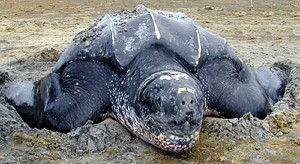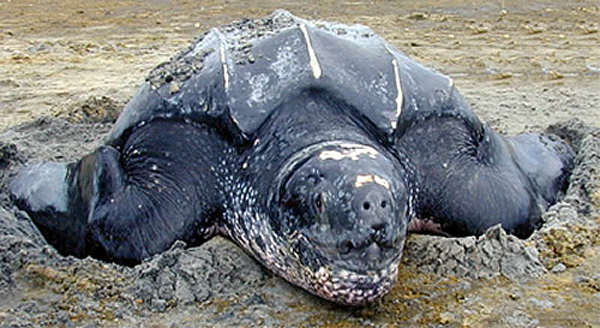– gillnet fishing, inadequate funding cited
The World Wildlife Fund (WWF) Guianas said though Guyana’s marine turtle population has stabilised its level is still not “healthy” and gillnet fishing remains a threat.

WWF Guianas Regional Marine Turtle Coordinator Marie-Louise Felix said populations of the Green and Leatherback turtles, the species that nest predominately in Guyana, are not yet healthy. She made these statements during an exchange visit to Guyana earlier this month, with a three-member team from Suriname, to view the Guyana Marine Turtle Conservation Society’s (GMTCS) turtle conservation efforts at Almond Beach, Region One.
In addition, GMTCS Marine Turtle Country Coordinator Romeo DeFreitas said more funding is needed to increase its conservation efforts on the Shell Beaches of Region One as it hosts nesting turtles yearly from around March to August.
Globally, marine turtles are critically endangered or endangered since the once fairly abundant population has declined drastically. The WWF is working in other countries to help boost the marine turtle population because the numbers are too low to declare the population healthy.
For example, in Guyana, the Leatherback and Green marine turtles numbers are not dropping; an increase has been recorded in some years while the numbers remain stable in others. Felix posited that in general the turtles “are on the increase in Guyana” and the same can be said for Suriname. Suriname sees some 60% of the world’s Leatherback Turtles nesting on its beaches. However, there are some concerns about Leatherbacks because their numbers are still fewer than 30 years ago, Felix said.
In the WWF Guianas Highlight 2007, Guyana saw 1,762 Leatherbacks, compared to 7,380 in Suriname and 146 Green Turtles compared to 9,908 in Suriname; 41 Hawksbill Turtles compared to seven in Suriname and one Olive Ridley Turtle compared to 113 in Suriname. “Many, many adult turtles are being drowned in fish nets,” Felix said. Although shrimp trawlers are using the Turtle Excluder Devices (TEDs), gillnet fishing (which catches fish that try to pass through it by snagging on the gill covers) along the coast by local fishermen prevents turtles from reaching their nesting shores. While these nets allow the fishermen to maximize their catch, the female turtles need to swim to shore to nest. “This is the problem we face,” Felix said, acknowledging that the fishermen are also entitled to a livelihood.
Suggestions had been made to simply prohibit gillnet fishing or to have no netting areas.
Others have said that attaching blue or red lights to the nets will discourage turtles from gillnets as marine turtles are very sensitive to artificial light. Felix believes that working with the government and scientists to reach a solution, is the answer. At the same time, certain threats like poaching (killing of turtles for their eggs and meat) have reduced.
Funding
Felix admitted that the WWF has seen decreasing funding from donors and is encouraging its partners to begin seeking possible ways of developing conservation and economics. She said too it is possible that the WWF will have less and less funds to support projects. However, she is also advocating that any conservation/income generation project must be able to support its long-term objectives rather than bring in a lot of money in six months then fail.
Meanwhile, DeFreitas indicated that no cutbacks have been made from normal funding sources like WWF, Simpson Oil Ltd (Sol Gas) and the Chelonian Research Institute in Oviedo, Florida, whose President Peter CH Pritchard, PhD is co-founder of GMTCS. While the institute supports education and other shortfalls, Sol Gas gives around $1 million worth in oil and the WWF funds monitoring activities on the beaches. The GMTCS has been thus supported since the initiative started in 2000. GMTCS also offers tours to the Shell Beaches.
According to DeFreitas because of limited human resources this season the GMTCS will be monitoring just two beaches and even this will be “very, very tight”. He said the marine programme welcomes volunteers. Over the years volunteers have come from the President’s Youth Award and the US Peace Corps.
The nesting beaches are in need of large-scale clearing from fallen coconut trees due to erosion and other debris that have washed up from the ocean. The few hundred residents on the Shell Beaches earn a living through fishing and have coconut plantations, producing copra (dried coconut flesh) used to make coconut oil among other products. Although poaching on the Shell Beaches have declined from the highs of the ’80s, the biggest problem now is the changing nesting habits of the turtles in the area. DeFreitas said this is due to erosion of the beaches and the invasion of mud bars. It is difficult for the 80lb to half-tonne turtles to get through the mud, owing to their weight. As a result, they now have limited nesting areas, and when they come ashore they nest at little beaches which leave them vulnerable to local fishermen. It is also difficult to reach the turtles at the smaller beaches.
DeFreitas pointed out too that the project needs more support from the local people. Since 2000, only one beach has remained a constant nesting beach – that is Almond Beach where the current camp is located. Four beaches have since shifted and new ones are beginning to develop. DeFreitas believes the turtles may be confused by not being able to nest on the beaches they nested on two years ago.
“There is only so much more we can do,” he said, pointing out that if the GMTCS can raise more funds, its efforts can be extended. Currently the GMTC employs nine persons to monitor the beaches and DeFreitas said they are anxious to support and develop the capacity of the young people during the season. This includes boosting their literacy skills and education so that they have other employment options in addition to mining and logging, on conclusion of their stint at the GMTCS. Most of the staff are from Almond Beach.
For the last 21 years DeFreitas and his family, headed by Audley James have maintained a conservation programme on the Shell Beaches of Guyana. The GMTCS office is located at the Pegasus Hotel.

